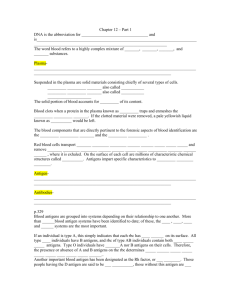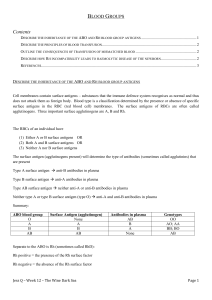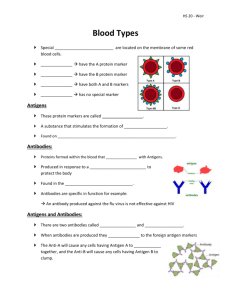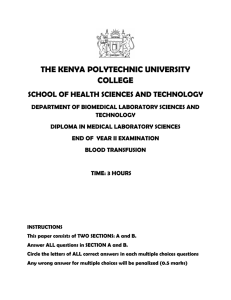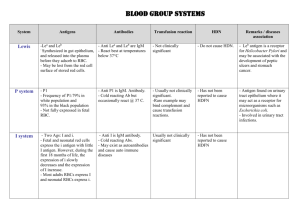1. About Blood Typing - Seabreeze High School
advertisement
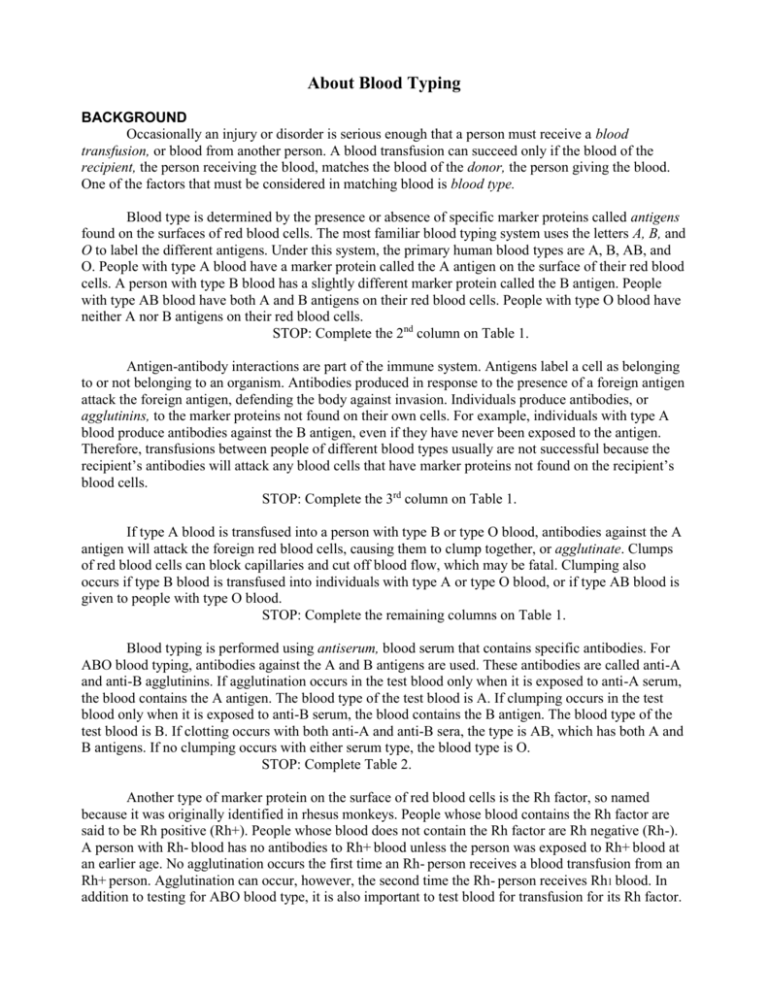
About Blood Typing BACKGROUND Occasionally an injury or disorder is serious enough that a person must receive a blood transfusion, or blood from another person. A blood transfusion can succeed only if the blood of the recipient, the person receiving the blood, matches the blood of the donor, the person giving the blood. One of the factors that must be considered in matching blood is blood type. Blood type is determined by the presence or absence of specific marker proteins called antigens found on the surfaces of red blood cells. The most familiar blood typing system uses the letters A, B, and O to label the different antigens. Under this system, the primary human blood types are A, B, AB, and O. People with type A blood have a marker protein called the A antigen on the surface of their red blood cells. A person with type B blood has a slightly different marker protein called the B antigen. People with type AB blood have both A and B antigens on their red blood cells. People with type O blood have neither A nor B antigens on their red blood cells. STOP: Complete the 2nd column on Table 1. Antigen-antibody interactions are part of the immune system. Antigens label a cell as belonging to or not belonging to an organism. Antibodies produced in response to the presence of a foreign antigen attack the foreign antigen, defending the body against invasion. Individuals produce antibodies, or agglutinins, to the marker proteins not found on their own cells. For example, individuals with type A blood produce antibodies against the B antigen, even if they have never been exposed to the antigen. Therefore, transfusions between people of different blood types usually are not successful because the recipient’s antibodies will attack any blood cells that have marker proteins not found on the recipient’s blood cells. STOP: Complete the 3rd column on Table 1. If type A blood is transfused into a person with type B or type O blood, antibodies against the A antigen will attack the foreign red blood cells, causing them to clump together, or agglutinate. Clumps of red blood cells can block capillaries and cut off blood flow, which may be fatal. Clumping also occurs if type B blood is transfused into individuals with type A or type O blood, or if type AB blood is given to people with type O blood. STOP: Complete the remaining columns on Table 1. Blood typing is performed using antiserum, blood serum that contains specific antibodies. For ABO blood typing, antibodies against the A and B antigens are used. These antibodies are called anti-A and anti-B agglutinins. If agglutination occurs in the test blood only when it is exposed to anti-A serum, the blood contains the A antigen. The blood type of the test blood is A. If clumping occurs in the test blood only when it is exposed to anti-B serum, the blood contains the B antigen. The blood type of the test blood is B. If clotting occurs with both anti-A and anti-B sera, the type is AB, which has both A and B antigens. If no clumping occurs with either serum type, the blood type is O. STOP: Complete Table 2. Another type of marker protein on the surface of red blood cells is the Rh factor, so named because it was originally identified in rhesus monkeys. People whose blood contains the Rh factor are said to be Rh positive (Rh+). People whose blood does not contain the Rh factor are Rh negative (Rh-). A person with Rh- blood has no antibodies to Rh+ blood unless the person was exposed to Rh+ blood at an earlier age. No agglutination occurs the first time an Rh- person receives a blood transfusion from an Rh+ person. Agglutination can occur, however, the second time the Rh- person receives Rh1 blood. In addition to testing for ABO blood type, it is also important to test blood for transfusion for its Rh factor. TABLE 1. TRANSFUSION CAPABILITIES OF DIFFERENT BLOOD TYPES Blood type Antigens on red Antibodies in Can receive blood Can give blood blood cells plasma from groups to groups A B AB O TABLE 2. AGGLUTINATION REACTION OF ABO BLOOD-TYPING SERA Blood Type Reaction A antibodies (anti-A serum) B antibodies (anti-B serum) A B AB O Questions Tom and Jane participate in a Red Cross blood drive at their school. Both are first-time donors. As part of the screening process their blood is typed. Tom is A+. Jane is AB+. 1. What blood group antibody is found in Tom’s blood? ________ 2. What blood group antigens are found in Jane’s blood? ________ 3. Could Jane’s blood cells be used for this transfusion? Explain your answer. EMTs bring 2 accident victims into the emergency room of the hospital. One victim is bleeding from a head wound and needs a transfusion of blood cells to replace what she has lost. She is AB+ 4. Could Tom’s blood be used for this transfusion? Explain your answer. 5. The second accident victim has also lost blood. He is B+. Could Jane’s blood cells be used for this transfusion? Explain your answer. 6. Could Tom’s blood cell be used for this transfusion? Explain your answer. Additional help with Blood Typing: Read more about it. Try sample problems! http://www.biology.arizona.edu/Human_Bio/problem_sets/blood_types/Intro.html Blood Transfusion simulation: Read the directions then play the transfusion game. http://nobelprize.org/educational_games/medicine/landsteiner/index.html



